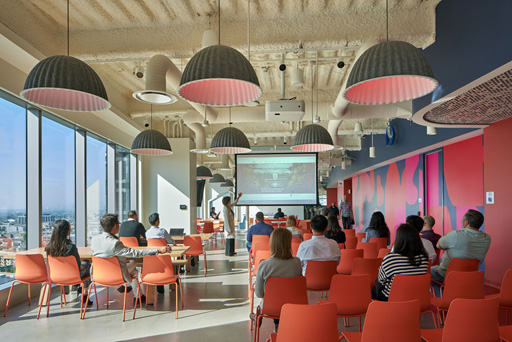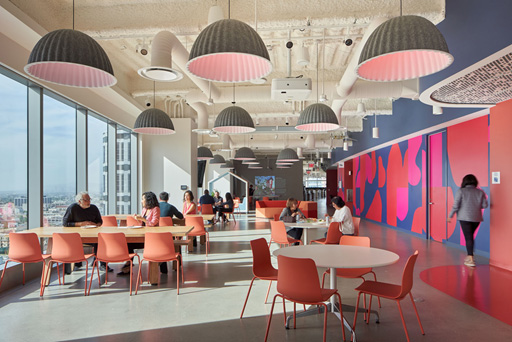Back to the Workplace: Human-Centric AV Design Means Asking Workers for Input
By Kirsten Nelson

 More displays might be needed in the open-area meeting places that are likely to be built in the aftermath of the pandemic. Photo by Bruce Damonte.
More displays might be needed in the open-area meeting places that are likely to be built in the aftermath of the pandemic. Photo by Bruce Damonte.
Since the dot-com boom (and bust, and subsequent high-tech revolution) at the turn of this century, the workplace has been shifting to a more human-centric model. Now, the casual office evolution is continuing in an even more employee-centric way, as enterprises consider how people might want to come back to the workplace after months of stay-at-home orders.
Rather than producing top-down directives and strict restrictions on work-from-home days, companies are asking team members for their personal input: Now that you’ve had a prolonged period of time working remotely, how would you like to work in the future? And, more importantly, what would make you feel safe in the workplace?
Related: AVIXA Webinars | Returning to the Workplace in a World of Heightened Sensory
COVID-19 will not only change the way we work, it will change how we interact with people and physical objects.
The answer to those questions will be highly individualized, varying widely according to hands-on work requirements and more personal questions of health and family caretaking concerns. But one common thread to any new scenario is the fact that audiovisual and communications technology will become even more central to workplace functionality.
It’s been said for many years now, but truly, now human factors are at the center of technology systems design. Once the surveys are complete, a new customization of workspaces will be needed, and more than likely that will involve many more screens and many new areas enabled with displays and collaboration capabilities as enterprises explore new ways to bring in remote workers.
Related: Back to the Workplace: Harnessing Data in AV Designs
Even more than before the pandemic, people have grown accustomed to the one-to-one nature of video meetings, with each speaker gaining a full screen as they speak. As such, they’re unlikely to give up their individual laptop view of meetings as they participate in videoconferences.
“Our relationship to screens may be changing a little bit, because we're going to be Zooming during a regular meeting, with half the people off-site and half the people in the room,” observes Paul Chavez, Associate, User Experience and Technology Design with Arup [ https://www.arup.com/ ]. “In some cases, the unified display will give way to distributed displays, and people can manage what they’re looking at. The interaction might be better, because you may be able to see individuals closer, and you can autonomously change your view of the meeting participants or slides in a presentation.”
 When returning to the office, workers might opt to have a meeting in a cafe or lounge area instead of a confined room. Photo by Bruce Damonte
When returning to the office, workers might opt to have a meeting in a cafe or lounge area instead of a confined room. Photo by Bruce Damonte
That might mean the end of the unpleasant experience of being a remote caller viewing a room from the far end of a long conference table, where no one in the room is really visible to the remote participant. (Unless there’s a great automated PTZ camera and switching setup happening, of course.)
Fear not, though, AV professionals, because even if the giant display at the front of the meeting room may fade out, more displays might be needed in the open-area meeting places that are likely to be built in the aftermath of the pandemic. This shift will amplify the more fluid meeting space tendencies that were already occurring in offices, where people might opt to have a meeting in a cafe or lounge area instead of a confined room.
Related: Guiding Your Corporate Clients Through Workplace Changes
Additionally, there’s the ever-present question of audio. How are all of those video chat feeds going to be aggregated? There may be a need for a processing device that handles all the incoming audio signals for a main room loudspeaker system, while also enabling use of individual laptop microphones for people in the room.
New hardware solutions may emerge and require integration into other environmental AV devices, Chavez suggests. The audio aggregator and processor of the future “might also be the room controller for lighting and other things as well.”
There will be a need to develop these and other AV tools to bring comfort and functionality to the workplace as it adapts and shifts to suit even more individualized needs. Video might also provide one other key element to aid in workers feeling safe when returning. “Possibly giving people virtual views of the new conditions in the offices, so that they can see that care is being taken,” Chavez suggested. This could assure people that changes have been made and the situation is continuing to be monitored — once again using audiovisual technology to communicate vital information in a changing landscape.
Read Next: Back to the Workplace: Harnessing Data in AV Designs





d6795920-eaf6-408e-b064-10b247156888.png?sfvrsn=6773b7ba_1)